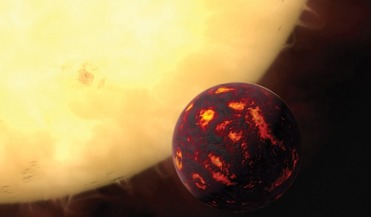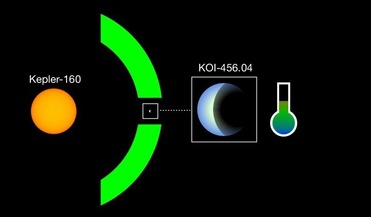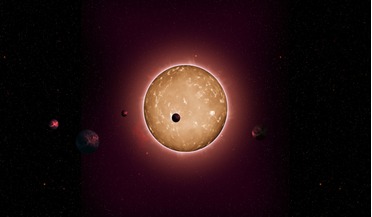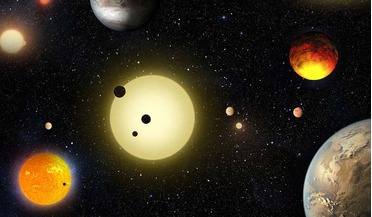ROOM: The Space Journal is one of the leading magazines on space exploration, technology and industry. At ROOM, we share a common goal – advancement of peaceful space exploration for the benefit of humankind, all while bringing you fascinating articles on an assortment,a range of contemporary topics. Our authors include researchers and industry leaders from all over the world, which lets us bring you the most up-to-date and accurate information about kepler exoplanets discovered.
 April 2019
Scanning the skies for exoplanets
April 2019
Scanning the skies for exoplanets
... orbit their host stars in 13 days or less; these are considered short orbital period exoplanets. Conversely, Kepler was adept at finding exoplanets with orbital periods from 10 days up to a few hundred days, a feature that proved invaluable time and... times the size of Earth, but with a whopping 23 times its mass and only two other exoplanets have been discovered that are this dense. But the compacted quality of this heavy world doesn’t just mean...
 August 2018
Exoplanet census promises radical discoveries
August 2018
Exoplanet census promises radical discoveries
... Kepler space telescope, progress has been rapid and surprising. The vast majority of the more than 3,700 known exoplanets are unlike any of the planets in our solar system. Most of the known exoplanets have been discovered by... to detect and determine the masses of most of the planetary host stars it discovers. WFIRST will discover and measure the masses of thousands of exoplanets and their host stars with masses ranging down to less than the mass...
 March 2017
Twinkle - a mission to unravel the story of planets in our galaxy
March 2017
Twinkle - a mission to unravel the story of planets in our galaxy
... atmosphere in ground-based observations. The number of confirmed exoplanets discovered has dramatically increased recently. In 2016 the science team behind NASA’s Kepler spacecraft has announced a further 1,284 objects verified as ...targets observed by Twinkle will comprise known exoplanets discovered by existing and upcoming ground surveys in our galaxy (e.g. WASP or HATNet) and space observatories (Kepler-2, GAIA, Cheops and TESS). The Twinkle...
 05 June 2020
Exciting exoplanet find around sun-like star
05 June 2020
Exciting exoplanet find around sun-like star
...now found a system that is the mirror image of our own Sun-Earth system. Of the 4200+ exoplanets discovered in the last couple of decades since planet-hunting became a mainstream activity, most of them orbit red ...replica of our own host star. The detection of Kepler-160 is not new. It was discovered around ten years ago, followed by the confirmation of two exoplanets, called Kepler-160b and Kepler-160c, four years later. Both of these planets...
 19 November 2018
Kepler officially retires after receiving final "goodnight" commands
19 November 2018
Kepler officially retires after receiving final "goodnight" commands
...is exactly 388 years to the day since its namesake, German astronomer Johannes Kepler, who discovered the laws of planetary motion, passed away in 1630. Kepler was not without the occasional technical blip however; four years into...brightness for signs of Earth-sized exoplanets, its field-of-view had to be switched roughly every three months to compensate for the mechanical glitch. The work-around fix worked and Kepler was able to continue with an ...
 November 2018
How many people does it take to colonise an exoplanet?
November 2018
How many people does it take to colonise an exoplanet?
... its surface. Located at 4.2 light years (40,000 billion km), Proxima Centauri b is almost an ideal destination - as far as exoplanets go. But while this distance may be small by astronomical standards, it remains utterly vast on the human scale. The... living human colonists is a formidable challenge indeed. Artist’s concept of 51 Pegasi b, which was discovered in October 1995. The giant planet is about half the size of Jupiter and orbits its star...
 May 2018
PLATO the habitable zone explorer
May 2018
PLATO the habitable zone explorer
...’, in 1995 confirmed planets like Earth could exist elsewhere in the universe. It was the first exoplanet discovered orbiting a star like our own Sun. The discovery of the first exoplanetary system was confirmed in.... It will find thousands of planets, giving us a planetary census that builds on our knowledge from NASA’s Kepler, K2 and TESS space missions, and extending it in new directions that were previously inaccessible. Visualisation of PLATO ...
 24 November 2021
Astronomers discover more than 350 possible new exoplanets
24 November 2021
Astronomers discover more than 350 possible new exoplanets
...exoplanets and 17 new multi-planet systems, including one with two Saturn-sized gas giant planets located unusually close to one another. Launched by NASA on 7 March, 2009, the Kepler space telescope has in its lifetime helped to discover...-planet systems. Of these candidates, 366 have not been previously identified, they say. “Discovering hundreds of new exoplanets is a significant accomplishment by itself, but what sets this work apart is how it ...
 11 May 2016
Kepler scientists announce a major increase in confirmed exoplanet numbers
11 May 2016
Kepler scientists announce a major increase in confirmed exoplanet numbers
... a day, 7 days a week, 365 days a year looking for the tell-tale sign of a would be exoplanet. The technique Kepler uses is known as the transit method and it works by measuring the dip in star light as a planet passes...telescopes, it is no easy task to spot the genuine article. Since Kepler launched in 2009, 21 planets less than twice the size of Earth have been discovered in the habitable zones of their stars. The orange spheres represent the...